Related Research Articles
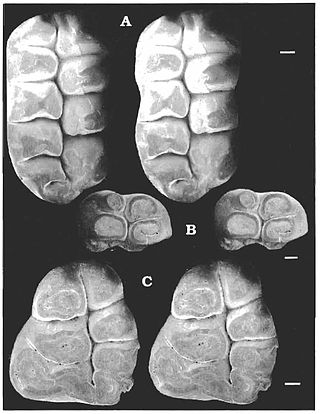
Catopsalis is a genus of extinct mammal from the Paleocene of North America. This animal was a relatively large member of the extinct order of Multituberculata. Most Multituberculates were much smaller.
Mesodma is an extinct genus of mammal, a member of the extinct order Multituberculata within the suborder Cimolodonta, family Neoplagiaulacidae. It lived during the upper Cretaceous and Paleocene Periods of what is now North America. The earliest definitive record is from the late Santonian stage strata of the Straight Cliffs Formation. A single premolar tooth from the lower Cenomanian stage strata of the Cedar Mountain Formation has been tentatively assigned to this genus based on its similarity, but its describers noted that it is unlikely that Mesodma lived during that time.
Baiotomeus is a genus of mammals from the extinct order of Multituberculata. It is known from the Paleocene of North America.
Prochetodon is a genus of mammals from the extinct order Multituberculata. It lived during the Upper Paleocene and the Lower Eocene in North America. The genus was formally named by G. L. Jepsen in 1940.
Microcosmodon is a mammal genus from the Paleocene of North America. It was a member of the extinct order Multituberculata, and lies within the suborder Cimolodonta and family Microcosmodontidae. The genus Microcosmodon was named by G.L. Jepsen in 1930.

The Paleocene–Eocene thermal maximum (PETM), alternatively "Eocene thermal maximum 1" (ETM1), and formerly known as the "Initial Eocene" or "Late Paleocene thermal maximum", was a time period with a more than 5–8 °C global average temperature rise across the event. This climate event occurred at the time boundary of the Paleocene and Eocene geological epochs. The exact age and duration of the event is uncertain but it is estimated to have occurred around 55.5 million years ago (Ma).

Simoedosaurus is an extinct reptile known from the Paleocene of North America, Europe and western Asia, and a member of the Choristodera, a group of aquatic reptiles that lived in the Northern Hemisphere from the Jurassic to the early Cenozoic.

The Fort Union Formation is a geologic unit containing sandstones, shales, and coal beds in Wyoming, Montana, and parts of adjacent states. In the Powder River Basin, it contains important economic deposits of coal, uranium, and coalbed methane.

Didymictis is an extinct genus of placental mammals from extinct subfamily Didymictinae within extinct family Viverravidae, that lived in North America and Europe from the late Paleocene to middle Eocene.
Arabemys is an extinct genus of sea turtle. It was first named in 1999, and contains one species, A. crassiscutata. It is known from deposits of Late Paleocene or Early Eocene age near the village of Linah in northern Saudi Arabia.
The Paleocene, or Palaeocene, is a geological epoch that lasted from about 66 to 56 million years ago (mya). It is the first epoch of the Paleogene Period in the modern Cenozoic Era. The name is a combination of the Ancient Greek παλαιός palaiós meaning "old" and the Eocene Epoch, translating to "the old part of the Eocene".
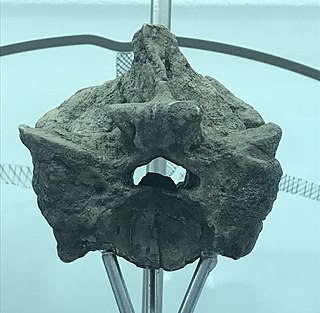
Titanoboa is an extinct genus of giant boid snake that lived during the middle and late Paleocene. Titanoboa was first discovered in the early 2000s by the Smithsonian Tropical Research Institute who, along with students from the University of Florida, recovered 186 fossils of Titanoboa from La Guajira in northeastern Colombia. It was named and described in 2009 as Titanoboa cerrejonensis, the largest snake ever found. It was originally known only from thoracic vertebrae and ribs, but later expeditions collected parts of the skull and teeth. Titanoboa is in the subfamily Boinae, being most closely related to other extant boines from Madagascar and the Pacific.
Bottosaurus is an extinct genus of alligatorid from the Late Cretaceous-Early Paleocene of New Jersey, Texas, and possibly North Carolina and South Carolina. Two species are currently accepted, with a third requiring re-evaluation.

The Paskapoo Formation is a stratigraphic unit of Middle to Late Paleocene age in the Western Canada Sedimentary Basin. The Paskapoo underlies much of southwestern Alberta, and takes the name from the Blindman River. It was first described from outcrops along that river, near its confluence with the Red Deer River north of the city of Red Deer, by Joseph Tyrrell in 1887. It is important for its freshwater aquifers, its coal resources, and its fossil record, as well as having been the source of sandstone for the construction of fire-resistant buildings in Calgary during the early 1900s.
The Ravenscrag Formation is a stratigraphic unit of early Paleocene age in the Western Canada Sedimentary Basin. It was named for the settlement of Ravenscrag, Saskatchewan, and was first described from outcrops at Ravenscrag Butte near the Frenchman River by N.B. Davis in 1918.
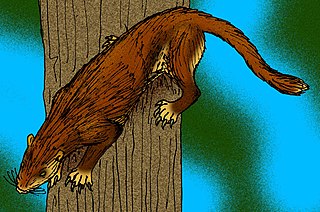
Hyopsodontidae is an extinct family of primitive mammals initially assigned to the order Condylarthra, living from the Paleocene to the Eocene in North America and Eurasia. Condylarthra is now thought to be a wastebasket taxon; hyopsodontids have occasionally been speculated to be related to Afrotheria, but the most recent consensus is that they are related to Perissodactyla. Analysis of the inner ear shows shared characteristics with the Equoidea ; they may be a basal ungulate group near to perissodactyls.
Archaerhineura was a genus of amphisbaenian lizards in the family Rhineuridae that is now extinct. The only species is Archaerhineura mephitis, named in 2015 on the basis of a single fragment of the lower jaw from the Polecat Bench Formation in Park County, Wyoming, which dates to the late Paleocene. Archaerhineura is one of the oldest amphisbaenians and was part of an evolutionary radiation of Rhineuridae in the Paleocene several million years after the Cretaceous–Paleogene extinction event. This rhineurid radiation coincided with the radiation of another group of amphisbaenians, Amphisbaeniformes, which includes the still-extant families Blanidae and Amphisbaenidae. The presence of Archaerhineura and other Paleocene rhineurids in the western United States indicates that amphisbaenians, which would later have a nearly global distribution, originated in North America.
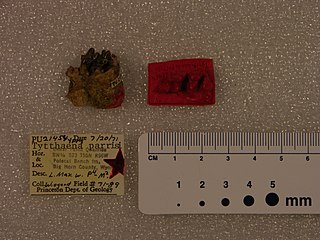
Tytthaena is an extinct genus of placental mammals from extinct subfamily Tytthaeninae within extinct family Oxyaenidae, that lived in North America from the late Paleocene to early Eocene.
Chiromyoides is a small plesiadapid primatomorph that is known for its unusually robust upper and lower incisors, deep dentary, and comparatively small cheek teeth. Species of Chiromyoides are known from the middle Tiffanian through late Clarkforkian North American Land Mammal Ages (NALMA) of western North America, and from late Paleocene deposits in the Paris Basin, France.
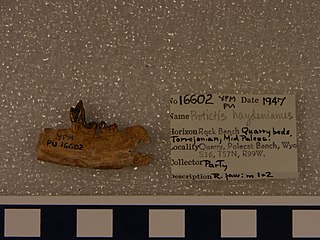
Protictis is an extinct paraphyletic genus of placental mammals from extinct subfamily Didymictinae within extinct family Viverravidae, that lived in North America from early Paleocene to middle Eocene.
References
- ↑ Radiolyarii paleotsena zapadnoi Kubani (Paleocene Radiolaria of Western Kubanj). NN Borisenko - Voprosy geologii, bureniya i ekspluatatsii skvashin ( …, 1958